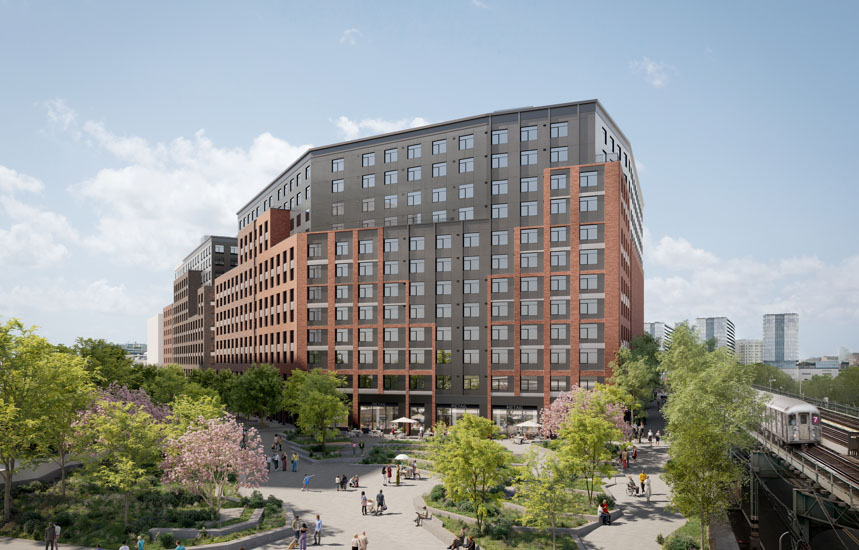COVID-19 and the future of American office spaces
As countries around the world upended decades-long trends and ways of living and working as a response to the COVID-19 pandemic, economies strained and buckled. Retail had already been struggling between the pull of online shoppers and companies’ commitment to brick-and-mortar despite past years’ struggles for physical stores. Lately, as much of the Global North, then South, went into lockdown, a strong digital presence paired with an ability to pivot on distribution has been essential for the sector to stay afloat.
Hospitality has essentially ground to a halt, with 39.3% of workers unemployed in the U.S. alone. Industrial has not only been hit hard by lockdown measures and the slowdown in economic activity, but pushed to its limits, as delicate global supply chains were disrupted at never-before-seen levels.
Office spaces, however, have been mostly overlooked in the general conversation, as office workers were essentially shifted into telecommuting overnight. But as lockdown measures are beginning to ease and business reopen, office spaces are emerging as a new battleground both on the economic front —due to widespread layoffs and shuttered businesses — as well as on the personal safety front.
Personal safety is especially important, as the decade-long push towards open office designs has reduced the space allocated per employee by 8.3% between 2009 and 2018 alone. In markets like Seattle and Washington, D.C., the space per employee has dropped to 135 square feet, making the required six-foot distancing difficult to implement.
Office to Incorporate Coworking Trends
So, how will office space evolve in the upcoming months and years, and what will the new normal look like, as people adapt to living with new habits and restrictions? The key seems to be merging traditional office trends with coworking influences into a new hybrid form of office space, centered on flexibility and personal safety.
Already in late March, 74% of CFOs were planning to move at least 5% of their on-site workforce to permanent work-from-home positions. A quarter of CFOs said they will shift 10% of their employees into permanently remote positions, while 17% were considering moving as much as 20% of their workers into permanent home office arrangements. And positive attitudes towards remote work have only strengthened since, a trend that will have serious implications for the U.S. office market, with rising vacancy rates a real concern.
“Many corporations are now rethinking their office space footprint needs going forward, as they realize that certain percentages of their employees can work from home. Taking into account that major firms are now considering relocating from Manhattan to the suburban office spaces, subleasing is the most sensible option to get rid of excess space,” according to DitchTheSpace CEO Jack Sitt.
Long-Term Remote Work Safest Bet for Most Companies
While the push for flexible work hours and telecommuting has been on a steady rise, especially as Millennials took over the employment market, most companies have been reticent to fully embrace it. However, as the pandemic took hold, essentially every employee who could work from home has been shifted into telecommuting. 62% of U.S. employees are now working from home and companies, from tech to banking, are integrating work-from-home policies into their long-term business plans.
As much of the world starts opening up, the threat of COVID-19 is as real as ever. Our understanding of the disease has evolved, but the new shape of everyday life remains hazy. The massive lockdowns meant to flatten the curve were only phase one — dubbed “the hammer” by Thomas Pueyo, known for making “flattening the curve” go viral. So, what follows the hammer, a move that quashes case and transmission rates by radical lockdowns and social distancing measures?
It’s “the dance”, a strategy based on alternating periods of easing and tightening of safety measures, successfully employed by regions that were hit early on, like South Korea and Hong Kong. It is this critical dance period that will most define the future of the office sector, as it will be a necessary reality until a cure or vaccine are discovered and deployed.
Most notably, the uncertainty and fluid nature of the dance has made much of corporate America decide it is safest to carry on working from home, in a complete 180-degree shift from previous attitudes. And it’s not just startups and tech giants who plan on continuing with overwhelmingly home office policies. While much of retail spending went down as the U.S. shut down, expenditure on equipment and software meant to facilitate working from home went up.
Work from Home Is Here To Stay
The investment already committed to work from home solutions and that to follow in the upcoming months, paired with the growing understanding of the connection between air flow and transmission rates, mean that offices and their notoriously divisive HVAC policies are under increasing scrutiny.
Simply put, workers cannot be packed safely into the same cramped offices as before, especially considering the prevalence of open office designs throughout corporate America (and beyond). Add to this the sweeping changes recommended by the new CDC guidelines, and the safest pandemic office seems to look more and more like everyone’s living room.
But even as much of the white-collar workforce can and plans to remain at home, some office workers will inevitably want and need to return to working from traditional offices. Limitations caused by lower-performance equipment, cramped or noisy living arrangements, higher risk tolerance, collaboration-intensive projects and the simple, yet overpowering human need for socializing will all contribute to push some workers into returning to the office.
Safety of Downtown Offices Under Scrutiny
Companies might start considering downsizing office footprints to cut costs under pressing economic conditions. But the math is more complicated than multiplying current footprint per capita by the number of employees remaining in work from home mode and giving that space up, due to the necessity of social distancing.
Whether and to what exact extent companies might downsize office space is also very much dependent on how long the wait for vaccines and treatments will be. Office workers also have to contend with risks beyond those of the office itself, with some of the most significant ones stemming from the ever-growing urban sprawl of most large metro areas.
While companies may ensure excellent screening and safety standards in the workplace, the cramped and complex commutes most office workers in large urban centers have to struggle with, paired with mobility choke points —elevators, escalators, stairs, and entry/exit points — bring another layer of risk to the traditional urban core office building to which workers flock from all over the city and suburbia beyond.
Although Millennials have moved to revitalized downtowns and packed urban living arrangements, suburban living and bedroom communities remain central to U.S. urban design. And it is this sprawling design paired with dense urban clusters that heighten the threat and likelihood of spread through the mobility funnel of commuting even in car-centric America.
The Return of The Cubicle
A niche trend re-emerging in the past years — partially as a result of gentrification, partially as result of rapidly increasing urban sprawl and density — may hold the key to a continued office culture: suburban office spaces. Specifically, suburban office spaces operating as satellite offices.
While implementing changes like staggered office hours, retrofitting desks with cubicle walls or Plexiglas, aggressive signage and PPE requirements, temperature checks and single-lane movement corridors can significantly increase safety by creating six square feet of office space per employee, large, commercial-district office spaces present particular challenges in limiting spread risk.
Medical space trends — such as increased automation for doors, elevators, bathroom fixtures etc., more aggressive adoption of paperless solutions, or retrofitting with materials that decrease contamination rates (such as copper) — will aggressively bleed into office design in the future. But centralized office spaces can only go so far in terms of contagion safety. However, smaller, less dense spaces bridge the gap between home offices and the downtown address.
The Case for Satellite & Suburban Offices
Not only do suburban satellite offices decrease risk by exponentially cutting potential contacts within the work environment, but they also allow for spreading out the workforce geographically in a specific urban area, resulting in shorter, less complex commutes, thus significantly decreasing the contamination risk of crowded public transport or elevators.
Additionally, they allow better access to professional office spaces as white-collar workforces, mostly clustered in large metropolitan areas, prepare for scaled easing and tightening of lockdowns in different cities, suburbs and communities. Especially as large metros like New York see areas outside the densely packed urban cluster open up well before the city itself.
New York specifically exemplifies the need for suburban satellite offices with its large office workforce and hyper-dense urban landscape. Hit hard by the pandemic, the State of New York is now slowly and carefully opening up again. But strict conditions for opening up mean that vertical and dense NYC will enter phase one of reopening only on June 8, while five regions of the state have already entered phase two on May 29.
Corporate giants have taken notice and are already searching for move-in-ready suburban offices outside the core of NYC, looking as far as Westchester and New Jersey.
The Coworking Sublease
While some companies are already scouting the market for move-in-ready suburban offices and others prepare to take the leap, it is becoming increasingly clear that this segment of office assets will see the highest interest in the near future. Not only do they allow easier access for workers but are also cheaper than downtown locations.
Coupled with the growing trend of live-work-play neighborhoods, suburban offices will only attract more attention, especially as some specialists warn that social distancing measures will be necessary into 2022.
But with limited suburban space, especially move-in-ready space, companies may need to think outside the box. Some may adopt the wheel and spoke model, giving up part of existing centralized space and spreading workers among multiple urban satellite offices. This setup can also aid in limiting contacts and pre-empting potential future micro-lockdowns affecting specific neighborhoods or communities.
Others may simply decide, especially in light of the CDC’s sweeping new guidelines for office buildings, that transitioning into long-term remote work policies is simply easier, safer and more cost-effective, potentially pushing them into giving up most or even all of their office footprints.
Additionally, with the continued economic fallout of the pandemic, some businesses will have to shutter completely. According to DitchTheSpace.com, “New York City could see office rents declining 25% and office vacancies reaching 20%, as NYC is now the center of the COVID-19 pandemic.”
However, considering the extended time frames usually covered by commercial lease terms, navigating the process of getting out of an office space or even just part of it can be a complex and costly undertaking. However, it need not be so when agile technological solutions like sublease ILSs exist.
Subleasing Emerges as Possible Solution
Subleasing is not a new process. Out of Manhattan’s 45 million square-foot Q1 office vacancy, nearly 25% represents sublease vacancy. In the case of San Francisco, sublease vacancies accounted for 32% of the total available office space at the start of 2020. Moreover, as the popularity of coworking spaces has grown, so has the trend of companies securing large coworking spaces for exclusive use, essentially going against the communal, idea-exchange grain of coworking.
“The social distancing era is likely to reduce the popularity of coworking spaces and so jumping into subleases will be the trend for tenants that need a private furnished space at attractive rent levels,” offered DitchTheSpace’s Jack Sitt. This trend will surely surge in the upcoming months as companies rush to diversify office footprints and locations.
As more of the U.S. returns to work while the health crisis continues, the professional environment office workers will discover will be very different from the one they left in March. The upcoming period will continue to test companies and the wider population alike, but agility, adaptability and flexibility will allow some companies to not only survive but thrive.
While office workers may be nostalgic for watercooler debates, there is also a growing, wider conversation on the imperfect nature of the pre-pandemic office. So, companies willing to embrace innovation and listen to their workers’ needs will emerge into the post-pandemic economy not only more productive and efficient, but also happier and more cohesive.
Related Cos. and Sterling Equities open housing lottery for Willets Point Commons


The CRE content gap: Why owners and brokers need better digital narratives in 2026 - by Kimberly Zar Bloorian







.gif)


.jpg)
.gif)